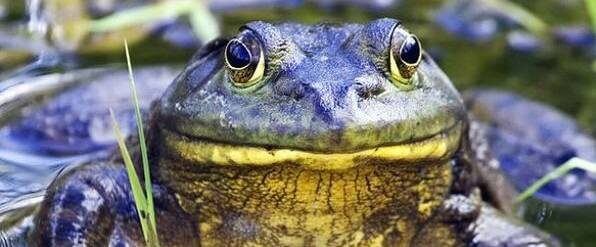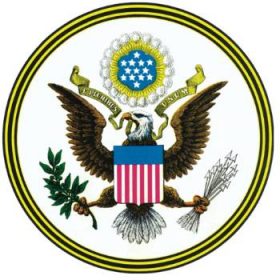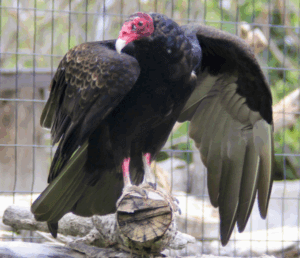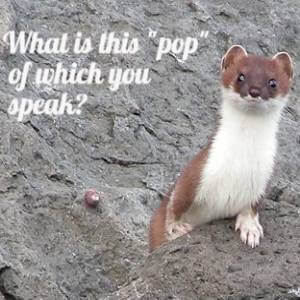RIP Giggin’ for Grads Night
June 24, 2025: We wrote about Giggin’ for Grads Night back in 2016. We’ve been unable to find any information since then about subsequent celebrations. We reached out to the DeKalb County Farmers Bureau to determine if the event has indeed been discontinued and if a new event has replaced it to fund scholarships for high school graduates. As of today, we’ve received no reply, so we have to assume that Giggin’ for Grads Night is no more.

The horror! The horror!
June 24, 2016: Today is the fourth Annual Giggin’ for Grads Night, created in 2013 by the DeKalb County Young Farmers and Ranchers Club of Smithville, Tennessee, to raise funds for agricultural scholarships. In case you’re unfamiliar with the terminology, “gigging” refers to the use of a sharpened implement, such as a pointed stick, called a “gig,” to spear fish. In this case, it refers to a bullfrog-spearing contest.
Participants pay a $15 entry fee and must hunt in teams of two to four people. First prize, for the heaviest bag of 15 frogs, is 25% of the entry fees collected. The second prize is 15%, and the third prize is 10%. Frogs are kept for a community frog leg dinner the next day.
While animal rights groups and many private citizens are appalled by this practice, it is a legal, regulated sport in Tennessee. Area game wardens supervise the tournament; giggers must have hunting licenses to participate and are allowed to kill no more than 20 frogs.
Danny Bryan, assistant professor of Biology at Cumberland University, said in an interview, “When a frog is gigged, it’s a humane way of killing the animal. Most of the time, when the frogs are gigged, that includes gigging the frog in the head, which is basically instant death,” said Bryan.
“As far as animal cruelty goes, I don’t much believe this event is any different than having some type of fishing rodeo or anything where you’re going out and catching fish to win a contest or going out to a catfish pond to catch catfish to cook for dinner.”
That first year, activists called club members, went on the news, and posted the local school principal’s number on social media in an effort to get Giggin’ for Grads canceled. As anyone who’s lived in a small town could predict, their approach backfired. The community responded to the outsiders’ efforts by digging in their heels and throwing their support behind the event.
People from nearby counties sent donations, bringing the scholarship total to over $1,000. The number of contestants grew from the expected twenty or so to nearly 100. As a result, many more frogs were killed—harvested, in gigging parlance—and fried the next day. The event has gained notoriety since then. Peaceful protestors return every year and are, by all accounts, treated well by the townsfolk.
One online petition circulating today has garnered 136,543 signatures. It includes this oft-repeated statement: “Bullfrogs are cold-blooded and have slow metabolisms, so it takes them a long time to die after being stabbed.” Requiring less energy to survive is a useful environmental adaptation, but it doesn’t slow the effect of a fatal stabbing. It doesn’t create Frankentoads or an amphibian GITMO in the gigger’s sack. Dead is dead. But this argument should at least prompt game wardens to remind everyone that the frogs they kill must be fully dead, sooner rather than later, because hunting isn’t about torture.
The petition also states that, in the darkness, participants kill other frogs and toads that may be endangered. The flashlights they carry, the incentive to get large bullfrogs, and the team aspect help reduce the likelihood of rogue giggers exterminating entire species or spending their time putting frogs in stress positions. Also, the US Fish and Wildlife Service has no record of any endangered frog species in Tennessee. If there are any, they are likely to be endangered because they took a left turn in Florida and ended up in Tennessee.
Giggin’ for Grads may be a terrible idea for a fundraiser. It has resulted in the death of thousands of bullfrogs. But perhaps there is a lesson to be learned from a mathematical standpoint. Aside from today’s event, there is a legal hunting season in which a licensed gigger can harvest up to 20 bullfrogs per day, every day…and yet they never run out. Maybe that shouldn’t matter, but think for a moment of another cold-blooded creature. When was the last time you cared if a cockroach suffered?
Have a happy Giggin’ for Grads Night, unless you don’t want to. No pressure!

 782, the American eagle, also known as the bald eagle, was chosen to grace the
782, the American eagle, also known as the bald eagle, was chosen to grace the 




 The short answer is that it’s probably nonsense verse made popular (no pun intended) because children enjoyed shouting, “Pop!” It’s believed to have originated in the 1700s in England, but the first official version of the song wasn’t published there until the 1850s. Within a few years, it jumped the pond and appeared in Boston and New York newspapers.
The short answer is that it’s probably nonsense verse made popular (no pun intended) because children enjoyed shouting, “Pop!” It’s believed to have originated in the 1700s in England, but the first official version of the song wasn’t published there until the 1850s. Within a few years, it jumped the pond and appeared in Boston and New York newspapers.